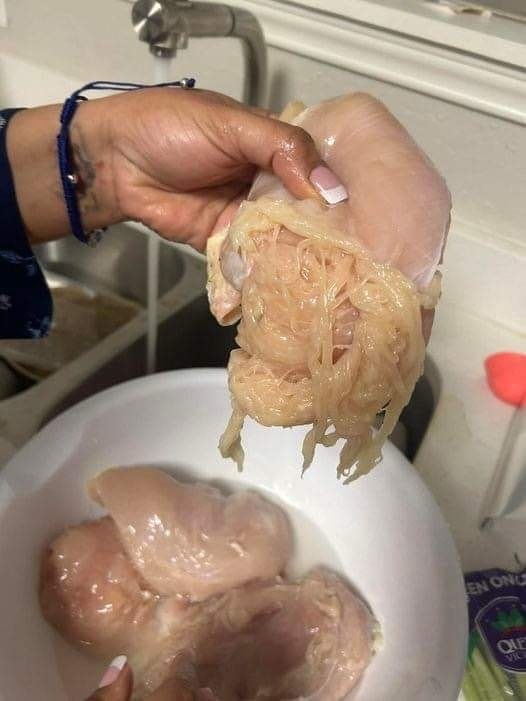Alesia Cooper, a mother residing in Irving, Texas, posted a picture of chicken breasts she had purchased. As soon as she began to prepare dinner, the chicken unexpectedly shredded into thin strands, resembling spaghetti, prompting her to seek advice on the issue.
“I been debating on posting this but since I had to see it so do yall,” she wrote under the photo she posted online on March 21.
“I was cooking my kids dinner a couple of weeks ago and was cleaning my meat like I normally do and when I went back to start cooking it turned into this (SIC).” Cooper explained.
Stating that the meat was bought from the budget supermarket Aldi, Cooper further wrote, “lol I think it’s that fake meat but I’m not sure anyways…I ain’t made chicken off the bone since.”
As expected, the photo was commented on by people who raised their concerns and shared their theories.
“That’s lab grown chicken, it’s a new way they make chicken because of the last few years with the bird flu and resource shortages they didn’t have produce so last year they announced that they found a way to make chicken in a lab and that’s what’s in stores now,” one person wrote.
“Fake i don’t buy it anymore,” another commented.
“It’s not lab-grown meat or 3D printed meat. It comes from real chickens. The problem is when greedy chicken producers force-feed their chickens growth hormones so they grow way too fast,” someone else added.
As reported by Wall Street, the chicken breast look like this, or take a spaghetti like look, when breeders feed chicken chemicals in order to make them grow bigger.
“There is proof that these abnormalities are associated with fast-growing birds,” said Dr. Massimiliano Petracci, an agriculture and food science professor at the University of Bologna in Italy.
“Back in the day, it would take chicken to reach 2.5 pounds market weight in 112 days, and in recent years, chickens reach the market weight of 5.03 pounds in average in 47 days.”
“If people keep eating more and more chicken, chickens will probably have to get even bigger…We’ll have to increase the proportion of breast meat in each bird, too.” said Dr. Michael Lilburn, a professor at Ohio State University’s Poultry Research Center.
“What people don’t realize is that it’s consumer demand that’s forcing the industry to adjust,” Lilburn said of the increased consumption of various chicken products such as chicken nuggets, wings, and sandwiches.
“It’s a deceivingly small but vocal minority that are raising a lot of legitimate questions. The bulk of the U.S. population still doesn’t care where their food comes from, as long as its cheap,” Liburn added.
It’s crucial to be vigilant about what we eat to protect our health and that of our children.









